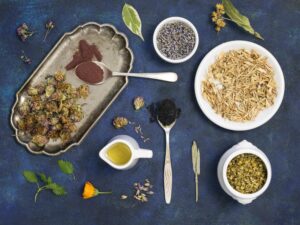आयुष्कामा भृंगा हेयर ऑयल – प्राकृतिक सौंदर्य का उपहार

आजकल की भागदौड़ भरी जिंदगी में बालों का झड़ना, रूसी, असमय सफेदी और रूखापन आम समस्याएँ बन गई हैं। प्रदूषण, तनाव और पोषण की कमी के कारण बालों का स्वास्थ्य प्रभावित होता है। इन समस्याओं के प्राकृतिक समाधान के लिए आयुष्कामा भृंगा हेयर ऑयल एक उत्तम आयुर्वेदिक उपचार है, जो बालों की जड़ों को पोषण देकर उन्हें मजबूत बनाता है।
आयुष्कामा भृंगा हेयर ऑयल क्यों चुनें?
यह विशेष रूप से तैयार किया गया है प्राचीन आयुर्वेदिक जड़ी-बूटियों के मिश्रण से, जो बालों को स्वस्थ और घना बनाने में सहायक हैं। इसमें शामिल हैं:
✅ भृंगराज – इसे ‘बालों का राजा’ कहा जाता है, यह बालों की ग्रोथ को बढ़ाता है और असमय सफेदी को रोकता है।
✅ आंवला – विटामिन C का खजाना, जो बालों की जड़ों को मजबूत करता है और चमक बढ़ाता है।
✅ ब्राह्मी – तनाव कम करता है और स्कैल्प में ब्लड सर्कुलेशन को बढ़ाता है।
✅ नीम – डैंड्रफ और स्कैल्प संक्रमण से बचाव करता है।
✅ नारियल एवं तिल का तेल – बालों को गहराई से पोषण देता है और रूखेपन को दूर करता है।
आयुष्कामा भृंग हेयर ऑयल के फायदे
✔️ बालों का झड़ना कम करे और जड़ों को मजबूत बनाए
✔️ डैंड्रफ और स्कैल्प संक्रमण से बचाए
✔️ बालों को घना और मजबूत बनाए
✔️ असमय सफेदी को रोके
✔️ बालों को गहराई से पोषण देकर चमकदार बनाए
✔️ तनाव कम करे और सिर को ठंडक पहुंचाए
कैसे उपयोग करें?
रात को सोने से पहले आयुष्कामा भृंग हेयर ऑयल को हल्के हाथों से सिर की त्वचा में मसाज करें और इसे रातभर लगा रहने दें। बेहतर परिणामों के लिए इसे सप्ताह में 2-3 बार लगाएँ।
अब अपने बालों को दें आयुर्वेदिक पोषण!
आयुष्कामा ऋषिकेश पर उपलब्ध
कॉल/व्हाट्सएप: +91 9917317388 | +91 8445889122
वेबसाइट: ayuskamarishikesh.com








